談JS實作AST抽象語法樹問題
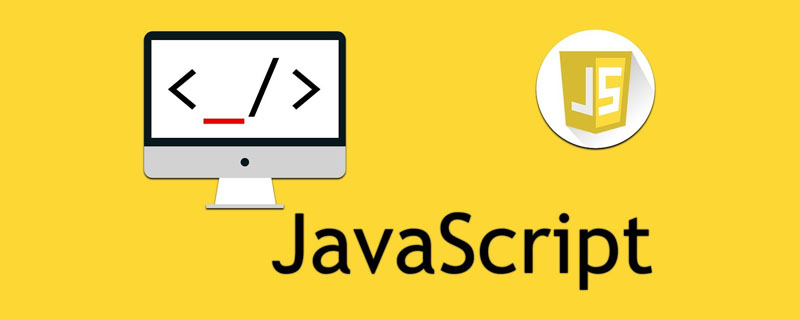
免費學習推薦:javascript學習教學
#前端中的AST抽象語法樹問題
- 四則運算
- 正規表示式
- 詞法分析
- 語法分析
- 完整程式碼
四則運算
首先明確,此次的程式碼都是基於LL的語法分析來實現的,實現的是四則混合運算的功能,先看下定義:
TokenNumber:· 1 2 3 4 5 6 7 8 9 0 的組合
Operator: - * / 之一
WhiteSpace:<sp></sp>
LineTerminator:
<lf></lf> <cr></cr>
#看下產生式: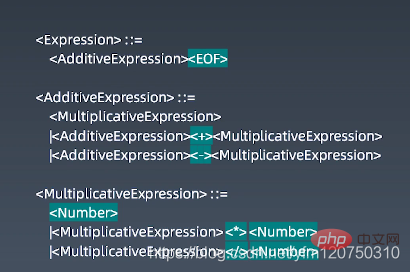
##正規表示式
我們先實作正規表示式的符合原則:<script>
var regexp = /([0-9\.]+)|([ \t]+)|([\r\n]+)|(\*)|(\/)|(\+)|(\-)/g
var dictionary = ["Number", "Whitespace", "LineTerminator", "*", "/", "+", "-"];
function tokenize(source) {
var result = null;
while(true) {
result = regexp.exec(source);
if(!result) break;
for(var i = 1; i <= dictionary.length; i ++) {
if(result[i])
console.log(dictionary[i - 1]);
}
console.log(result);
}
}
tokenize("1024 + 10 * 25");</script>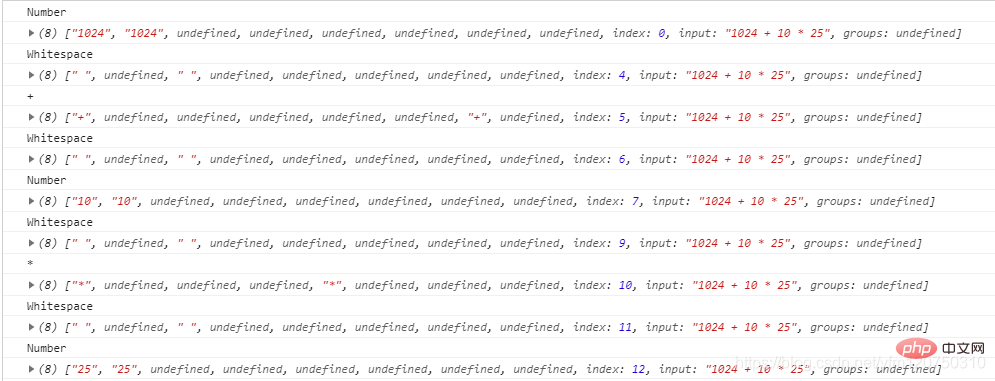 值得一提的是這裡用到了exec方法,exec() 方法用來檢索字串中的正規表示式的符合。
值得一提的是這裡用到了exec方法,exec() 方法用來檢索字串中的正規表示式的符合。
我們來看看它的語法:
RegExpObject.exec(string)
詞法分析
我們在這部分對上面的程式碼做最佳化。 首先是剛才提到的:
當 RegExpObject 是一個全域正規表示式時,exec() 的行為就稍微複雜一些。它會在 RegExpObject 的 lastIndex 屬性指定的字元處開始檢索字串 string。當 exec() 找到了與表達式相符的文字時,在匹配後,它將把 RegExpObject 的 lastIndex 屬性設定為匹配文字的最後一個字元的下一個位置。 那麼我們就要考慮到沒有符合上字元的情況,做一個判斷處理:
<script>
var regexp = /([0-9\.]+)|([ \t]+)|([\r\n]+)|(\*)|(\/)|(\+)|(\-)/g
var dictionary = ["Number", "Whitespace", "LineTerminator", "*", "/", "+", "-"];
function* tokenize(source) {
var result = null;
var lastIndex = 0;
while(true) {
lastIndex = regexp.lastIndex;
result = regexp.exec(source);
if(!result) break;
if(regexp.lastIndex - lastIndex > result[0].length)
break;
let token = {
type: null,
value: null
}
for(var i = 1; i <= dictionary.length; i ++) {
if(result[i])
token.type = dictionary[i - 1];
}
token.value = result[0];
yield token }
yield {
type: 'EOF'
}
}
for (let token of tokenize("1024 + 10 * 25")) {
console.log(token)
}</script>regexp.lastIndex - lastIndex 和 result[0] 的長度比較,判斷是否有字串沒有符合。 將整個函數改成generator函數的形式,我們看下運行的結果: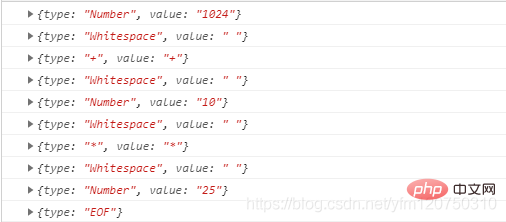
#語法分析
先寫分塊的產生式,我們來看看總的程式碼結構:<script>
var regexp = /([0-9\.]+)|([ \t]+)|([\r\n]+)|(\*)|(\/)|(\+)|(\-)/g
var dictionary = ["Number", "Whitespace", "LineTerminator", "*", "/", "+", "-"];
function* tokenize(source) {
var result = null;
var lastIndex = 0;
while(true) {
lastIndex = regexp.lastIndex;
result = regexp.exec(source);
if(!result) break;
if(regexp.lastIndex - lastIndex > result[0].length)
break;
let token = {
type: null,
value: null
}
for(var i = 1; i <= dictionary.length; i ++) {
if(result[i])
token.type = dictionary[i - 1];
}
token.value = result[0];
yield token }
yield {
type: 'EOF'
}
}
let source = [];
for(let token of tokenize("10 * 25")) {
if (token.type !== "Whitespace" && token.type !== "LineTerminator")
source.push(token);
}
function Expression(tokens) {
}
function AdditiveExpression(source){
}
function MultiplicativeExpresson(source) {
console.log(source);
}
MultiplicativeExpresson("10 * 25")</script>MultiplicativeExpresson來進行研究,它分為四種情況:
function MultiplicativeExpresson(source) {
//如果是数字则进行封装
if(source[0].type === "Number") {
let node = {
type: "MultiplicativeExpresson",
children:[source[0]]
}
source[0] = node;
return MultiplicativeExpresson(source)
}
//如果是乘号或者除号,则将三项出栈,进行重组
if(source[0].type === "MultiplicativeExpresson" && source[1] && source[1].type === "*") {
let node = {
type: "MultiplicativeExpresson",
operator: "*",
children: []
}
node.children.push(source.shift());
node.children.push(source.shift());
node.children.push(source.shift());
source.unshift(node);
return MultiplicativeExpresson(source)
}
if(source[0].type === "MultiplicativeExpresson" && source[1] && source[1].type === "/") {
let node = {
type: "MultiplicativeExpresson",
operator: "*",
children: []
}
node.children.push(source.shift());
node.children.push(source.shift());
node.children.push(source.shift());
source.unshift(node);
return MultiplicativeExpresson(source)
}
//递归结束的条件
if(source[0].type === "MultiplicativeExpresson")
return source[0];
return MultiplicativeExpresson(source);
}"10 * 25 / 2"時呼叫console.log(MultiplicativeExpresson(source))最後執行的結果: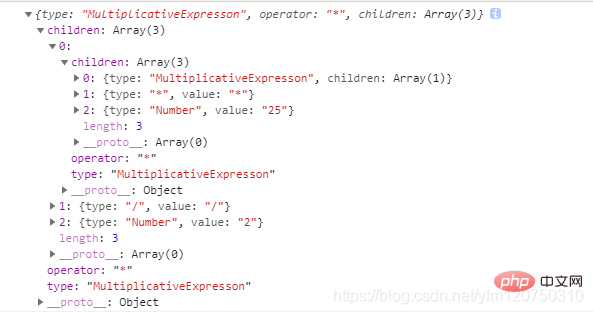 # 接下來看
# 接下來看
AdditiveExpression 本質上和MultiplicativeExpresson沒有什麼不同,差異點已經標註在程式碼當中了:
function AdditiveExpression(source){
if(source[0].type === "MultiplicativeExpresson") {
let node = {
type: "AdditiveExpression",
children:[source[0]]
}
source[0] = node;
return AdditiveExpression(source)
}
//如果是乘号或者除号,则将三项出栈,进行重组
if(source[0].type === "AdditiveExpression" && source[1] && source[1].type === "+") {
let node = {
type: "AdditiveExpression",
operator: "+",
children: []
}
node.children.push(source.shift());
node.children.push(source.shift());
//考虑到第三个数可能时Number 需要在这里再次调用一下 MultiplicativeExpresson 做处理
MultiplicativeExpresson(source);
node.children.push(source.shift());
source.unshift(node);
return AdditiveExpression(source)
}
if(source[0].type === "AdditiveExpression" && source[1] && source[1].type === "-") {
let node = {
type: "AdditiveExpression",
operator: "-",
children: []
}
node.children.push(source.shift());
node.children.push(source.shift());
MultiplicativeExpresson(source);
node.children.push(source.shift());
source.unshift(node);
return AdditiveExpression(source)
}
//递归结束的条件
if(source[0].type === "AdditiveExpression")
return source[0];
//第一次进循环 调用
MultiplicativeExpresson(source);
return AdditiveExpression(source);
}我们看一下当source为"10 * 25 / 2"时调用console.log(AdditiveExpression(source))最后运行的结果: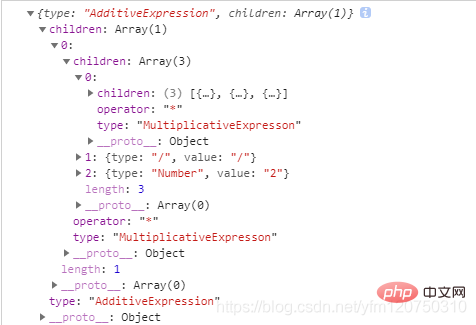
那么Expression的代码逻辑就很好表达了:
function Expression(tokens) {
if(source[0].type === "AdditiveExpression" && source[1] && source[1].type === "EOF") {
let node = {
type: "Expression",
children: [source.shift(), source.shift()]
}
source.unshift(node);
return node;
}
AdditiveExpression(source);
return Expression(source);
}看下运行后的结果: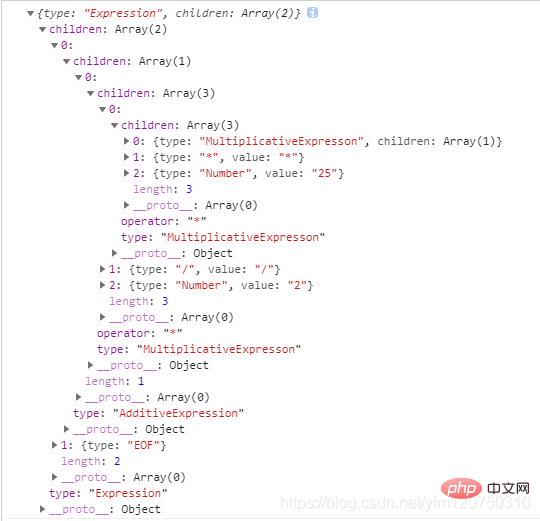
以上就是所有的js解析抽象语法树的代码。
完整代码
<script>
var regexp = /([0-9\.]+)|([ \t]+)|([\r\n]+)|(\*)|(\/)|(\+)|(\-)/g
var dictionary = ["Number", "Whitespace", "LineTerminator", "*", "/", "+", "-"];
function* tokenize(source) {
var result = null;
var lastIndex = 0;
while(true) {
lastIndex = regexp.lastIndex;
result = regexp.exec(source);
if(!result) break;
if(regexp.lastIndex - lastIndex > result[0].length)
break;
let token = {
type: null,
value: null
}
for(var i = 1; i <= dictionary.length; i ++) {
if(result[i])
token.type = dictionary[i - 1];
}
token.value = result[0];
yield token }
yield {
type: 'EOF'
}
}
let source = [];
for(let token of tokenize("10 * 25 / 2")) {
if (token.type !== "Whitespace" && token.type !== "LineTerminator")
source.push(token);
}
function Expression(tokens) {
if(source[0].type === "AdditiveExpression" && source[1] && source[1].type === "EOF") {
let node = {
type: "Expression",
children: [source.shift(), source.shift()]
}
source.unshift(node);
return node;
}
AdditiveExpression(source);
return Expression(source);
}
function AdditiveExpression(source){
if(source[0].type === "MultiplicativeExpresson") {
let node = {
type: "AdditiveExpression",
children:[source[0]]
}
source[0] = node;
return AdditiveExpression(source)
}
//如果是乘号或者除号,则将三项出栈,进行重组
if(source[0].type === "AdditiveExpression" && source[1] && source[1].type === "+") {
let node = {
type: "AdditiveExpression",
operator: "+",
children: []
}
node.children.push(source.shift());
node.children.push(source.shift());
//考虑到第三个数可能时Number 需要在这里再次调用一下 MultiplicativeExpresson 做处理
MultiplicativeExpresson(source);
node.children.push(source.shift());
source.unshift(node);
return AdditiveExpression(source)
}
if(source[0].type === "AdditiveExpression" && source[1] && source[1].type === "-") {
let node = {
type: "AdditiveExpression",
operator: "-",
children: []
}
node.children.push(source.shift());
node.children.push(source.shift());
MultiplicativeExpresson(source);
node.children.push(source.shift());
source.unshift(node);
return AdditiveExpression(source)
}
//递归结束的条件
if(source[0].type === "AdditiveExpression")
return source[0];
//第一次进循环 调用
MultiplicativeExpresson(source);
return AdditiveExpression(source);
}
function MultiplicativeExpresson(source) {
if(source[0].type === "Number") {
let node = {
type: "MultiplicativeExpresson",
children:[source[0]]
}
source[0] = node;
return MultiplicativeExpresson(source)
}
//如果是乘号或者除号,则将三项出栈,进行重组
if(source[0].type === "MultiplicativeExpresson" && source[1] && source[1].type === "*") {
let node = {
type: "MultiplicativeExpresson",
operator: "*",
children: []
}
node.children.push(source.shift());
node.children.push(source.shift());
node.children.push(source.shift());
source.unshift(node);
return MultiplicativeExpresson(source)
}
if(source[0].type === "MultiplicativeExpresson" && source[1] && source[1].type === "/") {
let node = {
type: "MultiplicativeExpresson",
operator: "*",
children: []
}
node.children.push(source.shift());
node.children.push(source.shift());
node.children.push(source.shift());
source.unshift(node);
return MultiplicativeExpresson(source)
}
//递归结束的条件
if(source[0].type === "MultiplicativeExpresson")
return source[0];
return MultiplicativeExpresson(source);
}
console.log(Expression(source))</script>相关免费学习推荐:javascript(视频)
以上是談JS實作AST抽象語法樹問題的詳細內容。更多資訊請關注PHP中文網其他相關文章!

熱AI工具

Undresser.AI Undress
人工智慧驅動的應用程序,用於創建逼真的裸體照片

AI Clothes Remover
用於從照片中去除衣服的線上人工智慧工具。

Undress AI Tool
免費脫衣圖片

Clothoff.io
AI脫衣器

Video Face Swap
使用我們完全免費的人工智慧換臉工具,輕鬆在任何影片中換臉!

熱門文章

熱工具

記事本++7.3.1
好用且免費的程式碼編輯器

SublimeText3漢化版
中文版,非常好用

禪工作室 13.0.1
強大的PHP整合開發環境

Dreamweaver CS6
視覺化網頁開發工具

SublimeText3 Mac版
神級程式碼編輯軟體(SublimeText3)
 如何使用WebSocket和JavaScript實現線上語音辨識系統
Dec 17, 2023 pm 02:54 PM
如何使用WebSocket和JavaScript實現線上語音辨識系統
Dec 17, 2023 pm 02:54 PM
如何使用WebSocket和JavaScript實現線上語音辨識系統引言:隨著科技的不斷發展,語音辨識技術已成為了人工智慧領域的重要組成部分。而基於WebSocket和JavaScript實現的線上語音辨識系統,具備了低延遲、即時性和跨平台的特點,成為了廣泛應用的解決方案。本文將介紹如何使用WebSocket和JavaScript來實現線上語音辨識系
 WebSocket與JavaScript:實現即時監控系統的關鍵技術
Dec 17, 2023 pm 05:30 PM
WebSocket與JavaScript:實現即時監控系統的關鍵技術
Dec 17, 2023 pm 05:30 PM
WebSocket與JavaScript:實現即時監控系統的關鍵技術引言:隨著互聯網技術的快速發展,即時監控系統在各個領域中得到了廣泛的應用。而實現即時監控的關鍵技術之一就是WebSocket與JavaScript的結合使用。本文將介紹WebSocket與JavaScript在即時監控系統中的應用,並給出程式碼範例,詳細解釋其實作原理。一、WebSocket技
 如何利用JavaScript和WebSocket實現即時線上點餐系統
Dec 17, 2023 pm 12:09 PM
如何利用JavaScript和WebSocket實現即時線上點餐系統
Dec 17, 2023 pm 12:09 PM
如何利用JavaScript和WebSocket實現即時線上點餐系統介紹:隨著網路的普及和技術的進步,越來越多的餐廳開始提供線上點餐服務。為了實現即時線上點餐系統,我們可以利用JavaScript和WebSocket技術。 WebSocket是一種基於TCP協定的全雙工通訊協議,可實現客戶端與伺服器的即時雙向通訊。在即時線上點餐系統中,當使用者選擇菜餚並下訂單
 如何使用WebSocket和JavaScript實現線上預約系統
Dec 17, 2023 am 09:39 AM
如何使用WebSocket和JavaScript實現線上預約系統
Dec 17, 2023 am 09:39 AM
如何使用WebSocket和JavaScript實現線上預約系統在當今數位化的時代,越來越多的業務和服務都需要提供線上預約功能。而實現一個高效、即時的線上預約系統是至關重要的。本文將介紹如何使用WebSocket和JavaScript來實作一個線上預約系統,並提供具體的程式碼範例。一、什麼是WebSocketWebSocket是一種在單一TCP連線上進行全雙工
 JavaScript與WebSocket:打造高效率的即時天氣預報系統
Dec 17, 2023 pm 05:13 PM
JavaScript與WebSocket:打造高效率的即時天氣預報系統
Dec 17, 2023 pm 05:13 PM
JavaScript和WebSocket:打造高效的即時天氣預報系統引言:如今,天氣預報的準確性對於日常生活以及決策制定具有重要意義。隨著技術的發展,我們可以透過即時獲取天氣數據來提供更準確可靠的天氣預報。在本文中,我們將學習如何使用JavaScript和WebSocket技術,來建立一個高效的即時天氣預報系統。本文將透過具體的程式碼範例來展示實現的過程。 We
 簡易JavaScript教學:取得HTTP狀態碼的方法
Jan 05, 2024 pm 06:08 PM
簡易JavaScript教學:取得HTTP狀態碼的方法
Jan 05, 2024 pm 06:08 PM
JavaScript教學:如何取得HTTP狀態碼,需要具體程式碼範例前言:在Web開發中,經常會涉及到與伺服器進行資料互動的場景。在與伺服器進行通訊時,我們經常需要取得傳回的HTTP狀態碼來判斷操作是否成功,並根據不同的狀態碼來進行對應的處理。本篇文章將教你如何使用JavaScript來取得HTTP狀態碼,並提供一些實用的程式碼範例。使用XMLHttpRequest
 javascript如何使用insertBefore
Nov 24, 2023 am 11:56 AM
javascript如何使用insertBefore
Nov 24, 2023 am 11:56 AM
用法:在JavaScript中,insertBefore()方法用於在DOM樹中插入一個新的節點。這個方法需要兩個參數:要插入的新節點和參考節點(即新節點將要插入的位置的節點)。
 JavaScript與WebSocket:打造高效率的即時影像處理系統
Dec 17, 2023 am 08:41 AM
JavaScript與WebSocket:打造高效率的即時影像處理系統
Dec 17, 2023 am 08:41 AM
JavaScript是一種廣泛應用於Web開發的程式語言,而WebSocket則是一種用於即時通訊的網路協定。結合二者的強大功能,我們可以打造一個高效率的即時影像處理系統。本文將介紹如何利用JavaScript和WebSocket來實作這個系統,並提供具體的程式碼範例。首先,我們需要明確指出即時影像處理系統的需求和目標。假設我們有一個攝影機設備,可以擷取即時的影像數






